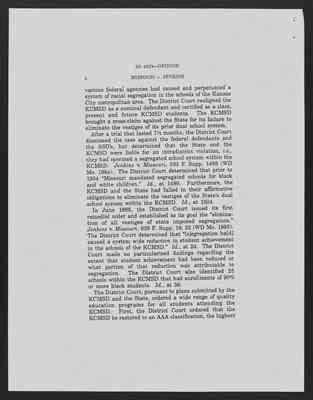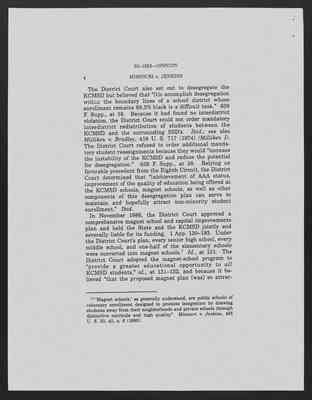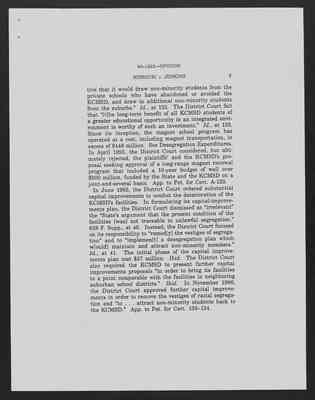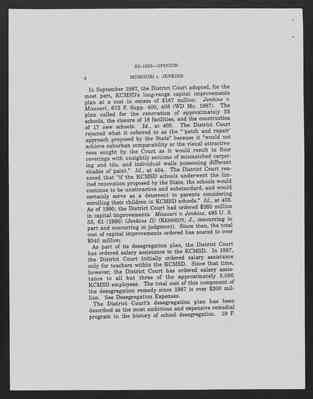Pages
6
2
93-1823—OPINION
MISSOURI v. JENKINS
various federal agencies had caused and perpetuated a system of racial segregation in the schools of the Kansas City metropolitan area. The District Court realigned the KCMSD as a nominal defendant and certified as a class, present and future KCMSD students. The KCMSD brought a cross-claim against the State for its failure to eliminate the vestiges of its prior dual school system.
After a trial that lasted 7½ months, the District Court dismissed the case against the federal defendants and the SSD's, but determined that the State and the KCMSD were liable for an intradistrict violation, i.e., they had operated a segregated school system within the KCMSD. Jenkins v. Missouri, 593 F. Supp. 1485 (WD Mo. 1984). The District Court determined that prior to 1954 "Missouri mandated segregated schools for black and white children." Id., at 1504.
In June 1985, the District Court issued its first remedial order and established as its goal the "elimination of all vestiges of state imposed segregation." Jenkins v. Missouri, 639 F Supp. 19, 23 (WD Mo. 1985). The District Court determined that "[s]egregation ha[d] caused a system wide reduction in student achievement in the schools of the KCMSD." Id., at 24. The District Court made no particularized findings regarding the extent that student achievement had been reduced or what portion of that reduction was attributable to segregation. The District Court also identified 25 schools within the KCMSD that had enrollments of 90% or more black students. Id., at 36.
The District Court, pursuant to plans submitted by the KCMSD and the State, ordered a wide range of quality education programs for all students attending the KCMSD. First, the District Court ordered that the KCMSD be restored to an AAA classification, the highest
7
3
93-1823—OPINION
MISSOURI v. JENKINS
classification awarded by the State Board of Education. Id., at 26. Second, it ordered that the number of students per class be reduced so that the student-to-teacher ratio was below the level required for AAA standing. Id., at 28—29. The District Court justified its reduction in class size as
"an essential part of any plan to remedy the vestiges of segregation in the KCMSD. Reducing class size will serve to remedy the vestiges of past segregation by increasing individual attention and instruction, as well as increasing the potential for desegregative educational experiences for KCMSD students by maintaining and attracting non-minority enrollment." Id., at 29.
The District Court also ordered programs to expand educational opportunities for all KCMSD students: full-day kindergarten; expanded summer school; before- and after-school tutoring; and an early childhood development program. Id., at 30—33. Finally, the District Court implemented a state-funded "effective schools" program that consisted of substantial yearly cash grants to each of the schools within the KCMSD. Id., at 33—34. Under the "effective schools" program, the State was required to fund programs at both the 25 racially identifiable schools as well as the 43 other schools within the KCMSD. Id., at 33.
The KCMSD was awarded an AAA rating in the 1987—1988 school year, and there is no dispute that since that time it has "'maintained and greatly exceeded AAA requirements.'" 19 F. 3d 393, 401 (CA8 1994) (Beam, J., dissenting from denial of rehearing en banc). The total cost for these quality education programs has exceeded $220 million. Missouri Department of Elementary Secondary Education, KCMSD Total Desegregation Program Expenditures (Sept. 30, 1994) (Desegregation Expenditures).
8
4
93-1823—OPINION
MISSOURI v. JENKINS
The District Court also set out to desegregate the KCMSD but believed that "[t]o accomplish desegregation within the boundary lines of a school district whose enrollment remains 68.3% black is a difficult task." 639 F. Supp., at 38. Because it had found no interdistrict violation, the District Court could not order mandatory interdistrict redistribution of students between the KCMSD and the surrounding SSD's. Ibid.; see also Milliken v. Bradley, 418 U. S. 717 (1974) (Milliken I). The District Court refused to order additional mandatory student reassignments because they would "increase the instability of the KCMSD and reduce the potential for desegregation." 639 F. Supp., at 38. Relying on favorable precedent from the Eighth Circuit, the District Court determined that "[a]chievement of AAA status, improvement of the quality of education being offered at the KCMSD schools, magnet schools, as well as other components of this desegregation plan can serve to maintain and hopefully attract non-minority student enrollment." Ibid.
In November 1986, the District Court approved a comprehensive magnet school and capital improvements plan and held the State and the KCMSD jointly and severally liable for its funding. 1 App. 130-193. Under the District Court's plan, every senior high school, every middle school, and one-half of the elementary schools were converted into magnet schools.1 Id., at 131. The District Court adopted the magnet-school program to "provide a greater educational opportunity to all KCMSD students," id., at 131-132, and because it believed "that the proposed magnet plan [was] so attrac-
- - - - - 1" 'Magnet schools,' as generally understood, are public schools of voluntary enrollment designed to promote integration by drawing students away from their neighborhoods and private schools through distinctive curricula and high quality." Missouri v. Jenkins, 495 U. S. 33, 40, n. 6 (1990).
9
5
93-1823—OPINION
MISSOURI v. JENKINS
tive that it would draw non-minority students from the private schools who have abandoned or avoided the KCMSD, and draw in additional non-minority students from the suburbs." Id., at 132. The District Court felt that "[t]he long-term benefit of all KCMSD students of a greater educational opportunity in an integrated environment is worthy of such an investment." Id., at 133. Since its inception, the magnet school program has operated at a cost, including magnet transportation, in excess of $448 million. See Desegregation Expenditures. In April 1993, the District Court considered, but ultimately rejected, the plaintiffs' and the KCMSD's proposal seeking approval of a long-range magnet renewal program that included a 10-year budget of well over $500 million, funded by the State and the KCMSD on a joint-and-several basis. App. to Pet. for Cert. A-123.
In June 1985, the District Court ordered substantial capital improvements to combat the deterioration of the KCMSD's facilities. In formulating its capital-improvements plan, the District Court dismissed as "irrelevant" the "State's argument that the present condition of the facilities [was] not traceable to unlawful segregation." 639 F. Supp., at 40. Instead, the District Court focused on its responsibility to "remed[y] the vestiges of segregation" and to "implemen[t] a desegregation plan which w[ould] maintain and attract non-minority members." Id., at 41. The initial phase of the capital improvements plan cost $37 million. Ibid. The District Court also required the KCMSD to present further capital improvements proposals "in order to bring its facilities to a point comparable with the facilities in neighboring suburban school districts." Ibid. In November 1986, the District Court approved further capital improvements in order to remove the vestiges of racial segregation and "to . . . attract non-minority students back to the KCMSD." App. to Pet. for Cert. 133—134.
10
6
93-1823—OPINION
MISSOURI v. JENKINS
In September 1987, the District Court adopted, for the most part, KCMSD's long-range capital improvements plan at a cost in excess of $187 million. Jenkins v. Missouri, 672 F. Supp. 400, 408 (WD Mo. 1987). The plan called for the renovation of approximately 55 schools, the closure of 18 facilities, and the construction of 17 new schools. Id., at 405. The District Court rejected what it referred to as the " 'patch and repair' approach proposed by the State" because it "would not achieve suburban comparability or the visual attractiveness sought by the Court as it would result in floor coverings with unsightly sections of mismatched carpeting and tile, and individual walls possessing different shades of paint." Id., at 404. The District Court reasoned that "if the KCMSD schools underwent the limited renovation proposed by the State, the schools would continue to be unattractive and substandard, and would certainly serve as a deterrent to parents considering enrolling their children in KCMSD schools." Id., at 405. As of 1990, the District Court had ordered $260 million in capital improvements. Missouri v. Jenkins, 495 U. S. 33, 61 (1990) (Jenkins II) (KENNEDY, J., concurring in part and concurring in judgment). Since then, the total cost of capital improvements ordered has soared to over $540 million.
As part of its desegregation plan, the District Court has ordered salary assistance to the KCMSD. In 1987, the District Court initially ordered salary assistance only for teachers within the KCMSD. Since that time, however, the District Court has ordered salary assistance to all but three of the approximately 5,000 KCMSD employees. The total cost of this component of the desegregation remedy since 1987 is over $200 million. See Desegregation Expenses.
The District Court's desegregation plan has been described as the most ambitious and expensive remedial program in the history of school desegregation. 19 F.




